Victor Victapen Standard Size c. late 1930s
by Jim Mamoulides, October 18, 2024
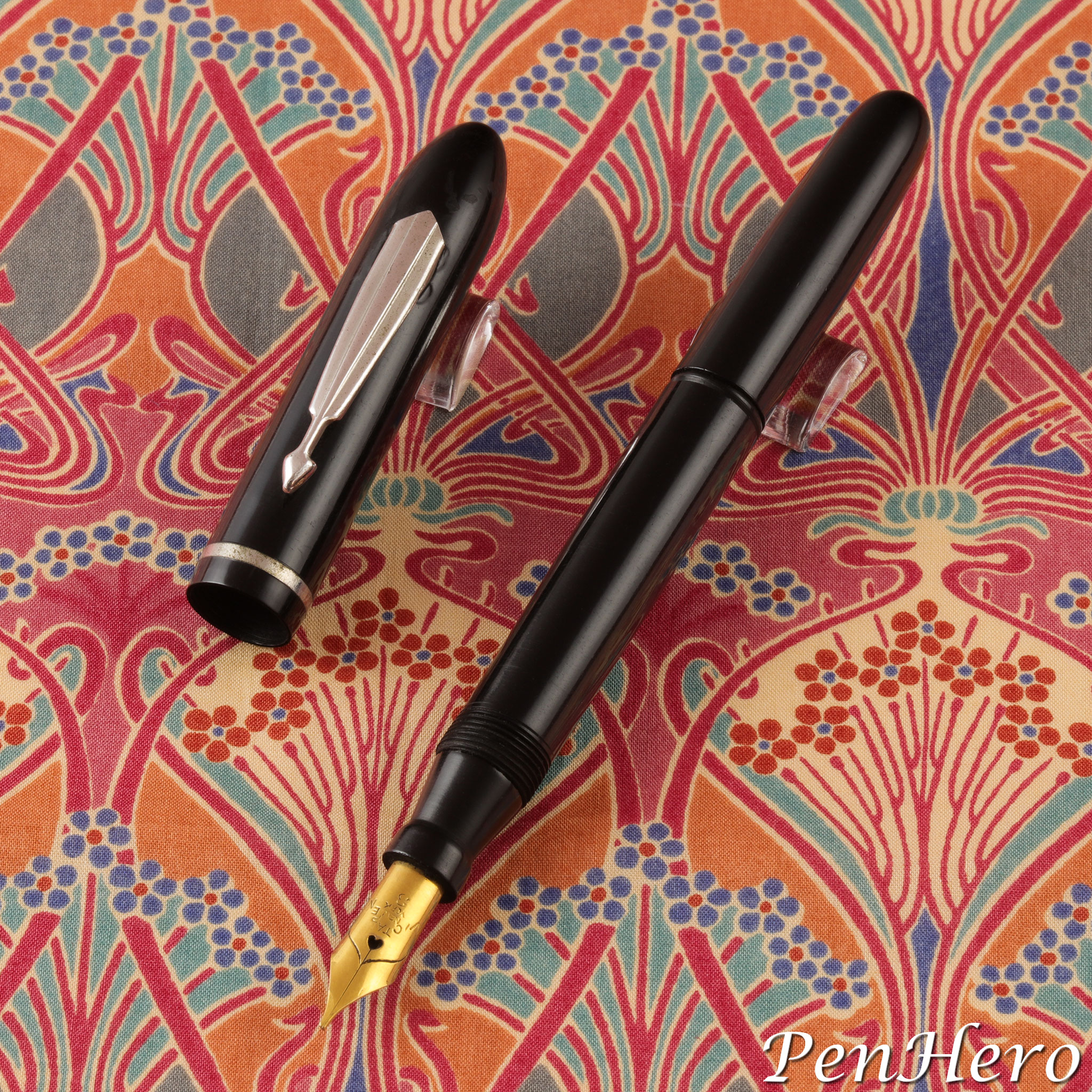 Victor Victapen standard size fountain pen black c. late 1930s
Victor Victapen standard size fountain pen black c. late 1930s
A Full Size Victapen?
Up to now, I thought of the c. 1932–1949 convertible compact Victapen purely as a small pen, sold with a matching pencil, where the two could be reconfigured into a 5 to 5 ½ inch long pen and pencil combo by removing the caps from the barrels of both the fountain pen and the pencil, putting the pencil point onto the end of the pen barrel, and replacing the pen cap back on. I’ve managed to see and collect quite a few examples that cover much of the time of production and all of them are quite small, 3 13/16 to 4 inches long capped. Until this one.
I saw it on an eBay listing in Argentina, a country that the U. S. Victor Fountain Pen Company, the Victapen’s manufacturer, exported to in the 1940s. I had been looking for a black Victapen for some time. I placed the order and waited a week or so for it to arrive and when I opened the package, I was surprised to find a 5 1/16 inch long pen inside. I had to check the imprint to make sure it was the Victapen I ordered and there, on the barrel was NEW YORK over VICTAPEN next to MADE IN over U. S. A. The long blind cap revealed no ink sac inside, but the breather tube was there, and the design was the same as the smaller Victapens. This one, however, is a standard size pen.
This longer Victapen is not in any of the limited reference materials I've been able to gather nor are there any photos online. The clip and cap band match those on a pen and pencil set in a Bloomingdale’s advertisement in the December 22, 1936 New York Daily News. That set is called the Victapen "Midget" pen and pencil set. Could all those short Victapens be “Midgets”, and this one represents the standard size pen?
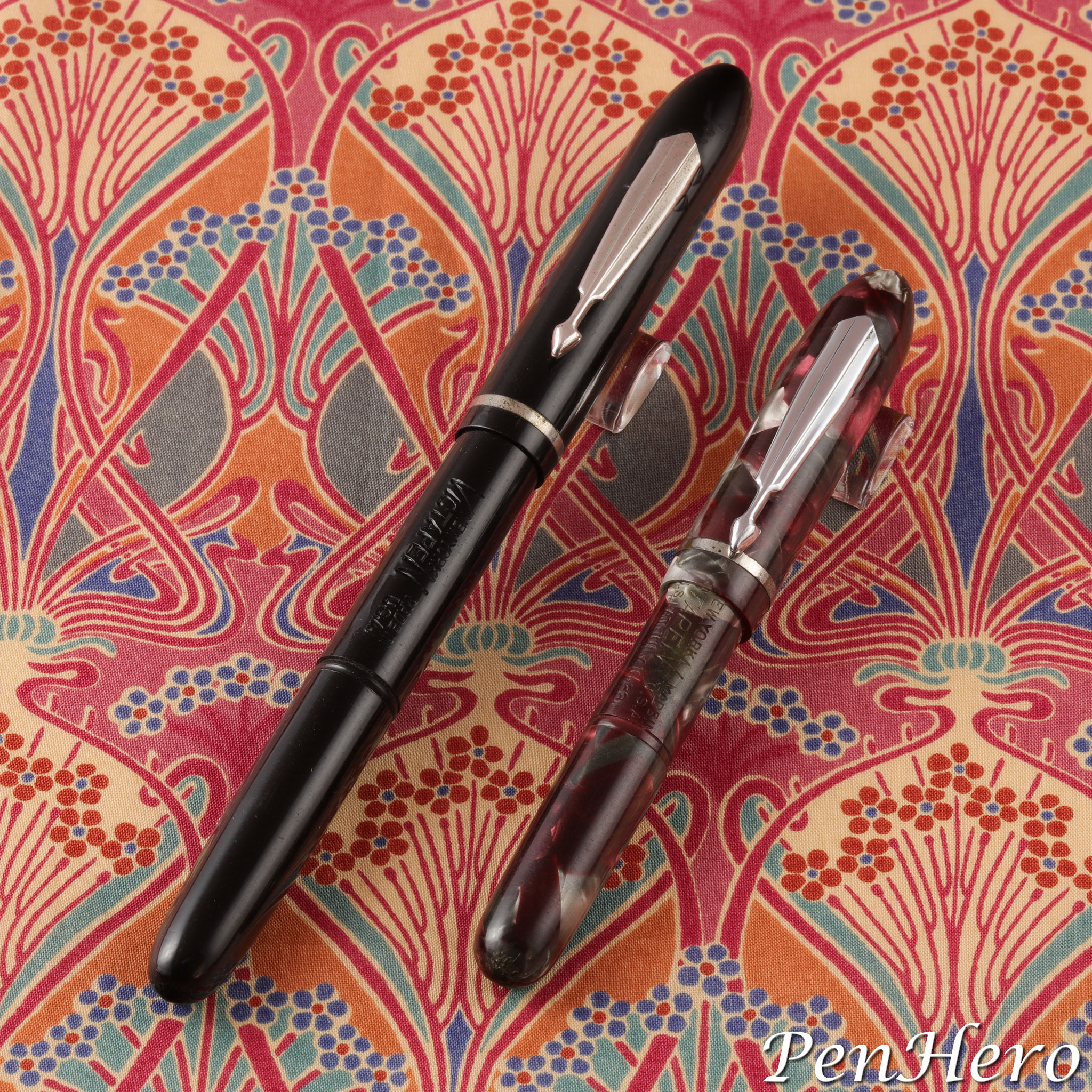 Victor Victapen standard size black with Victapen "Midget" rose and gray marble
Victor Victapen standard size black with Victapen "Midget" rose and gray marble
There are very few sources that help narrow down dates and times for the various celluloids, nibs, sizes, and trim used that account for the many variations of the small Victapen sets. I’ve found no Victapen catalogs or price lists, only a set of post-World War II instructions and a few advertisements that mention the Victapen. Very few ads are illustrated or show prices. One thing that has been consistent is all of the Victapens I’ve seen so far are quite small, 3 13/16 to 4 inches long capped, many were accompanied with the matching pencil, and several were complete with the small leather pouch. There is a strong indication, both from the convertable feature and the company materials I've reviewed, that Victapens were sold as pen and pencil sets.
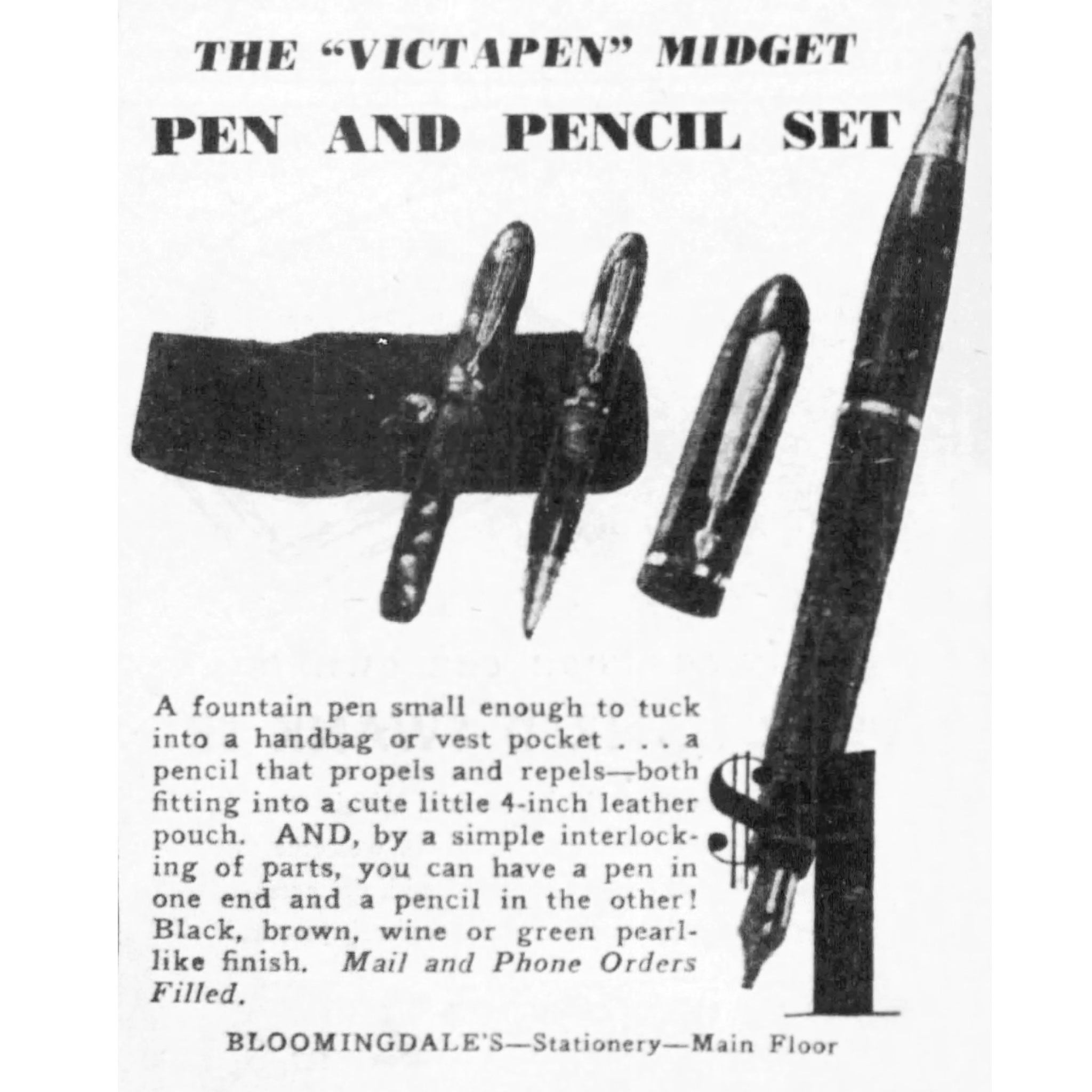 Advertisement in the December 22, 1936 New York Daily News
Advertisement in the December 22, 1936 New York Daily News
The Victapen was an idea of Edward Hugetz, president of the U. S. Victor Fountain Pen Company, and he applied for a patent on a bulb-filling fountain pen with an ink sac designed to fill the entire barrel, tapering onto the section nipple on May 11, 1932. The sac has a narrowed middle neck designed to fit through the threaded end of the barrel, ending with a bulb that fills the end cap. US patent no. 1,918,844 was awarded on July 18, 1933, for the invention. The pen operates by unscrewing the end cap and squeezing the bulb end to fill. The design includes a breather tube extending from the back of the feed into the ink sac all the way to the thread for the barrel end cap. The breather tube allows for a more complete filling, expelling air as ink enters the ink sac. The company called this “System Edward Hugetz” in post-World War II instructions included with the pen and pencil set. The convertable feature, making the pen and pencil into a combo instrument, is not mentioned in the patent.
The small Victapens came in a variety of celluloids, including stripes, marbled colors, and dashed stripes and with at least five clip designs. The May, 1932 patent application date is a clue to when the first Victapens may have been made and the company was seeking distributors for the newly patented pen by August, 1933 as seen in an advertisement in the Hartford Courant, and in many subsequent ads that year. Company advertisements for the Victor brand and the Victapen can be found through at least 1949, with the latest company advertisement I could find in the Mennonite Weekly Review, on September 8, 1949.
Identification guide and features:
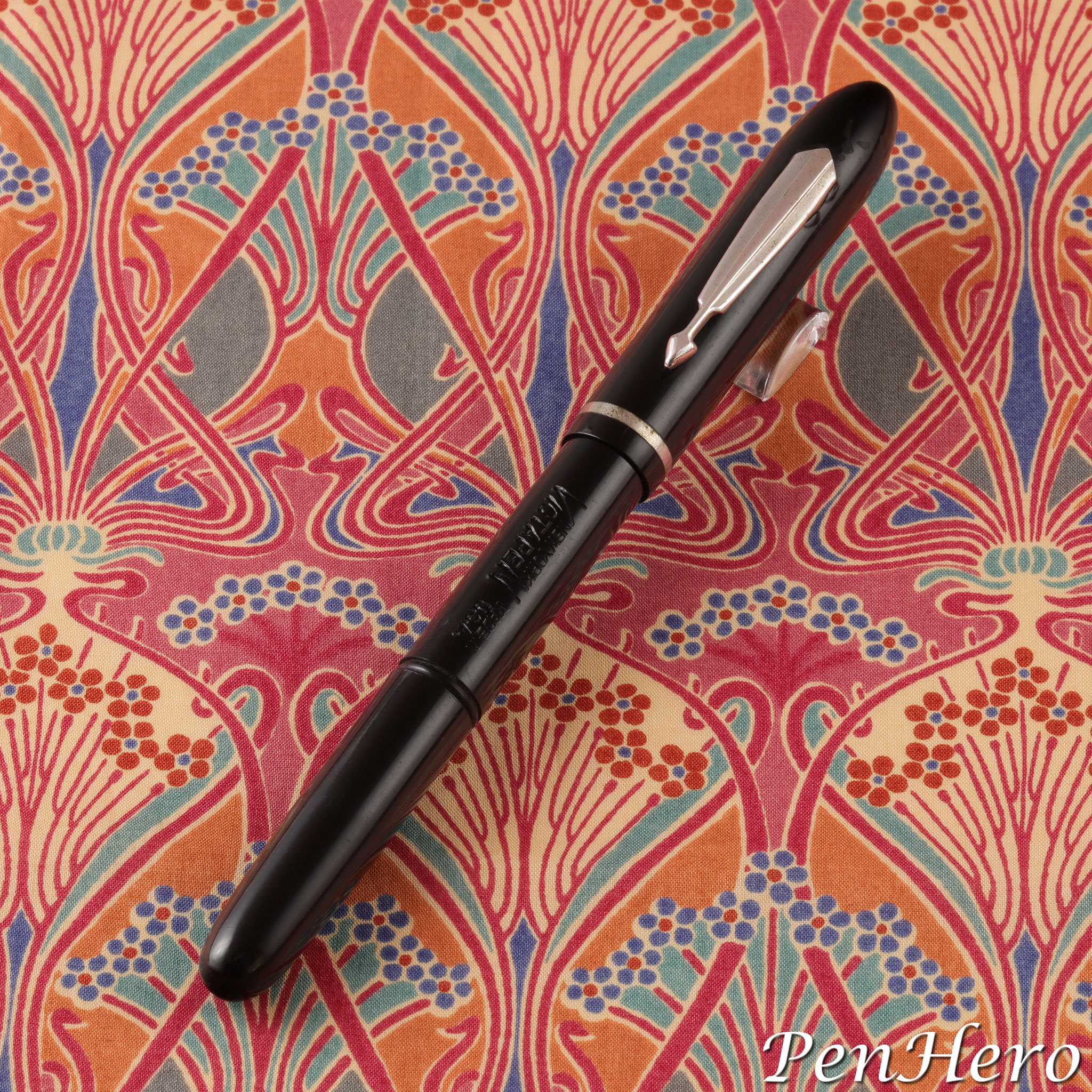 Victor Victapen standard size fountain pen black c. late 1930s
Victor Victapen standard size fountain pen black c. late 1930s
Although this is based solely on one example, I decided to detail out the specifications for comparison to the 3 13/16 inch long “Midget” Victapen with the same clip and trim shown above. This example appears to be identical to the smaller Victapen except for size. Early smaller celluloid pens c. 1932–42 are observed with a cap and barrel in a variety of marbled colors. Those pens will have a barrel imprint with NEW YORK over VICTAPEN next to MADE IN over U. S. A., all over U. S. PAT. JULY 18 ’33. This longer one lacks the patent imprint. The smaller pens were advertised as a men’s vest pocket or ladies’ handbag pen set and were 3 13/16 to 4 inches long capped. They were sold in the 1930s as pen and pencil sets in stores for $1 or direct from the manufacturer by mail order (plus 10 cents postage) and included a personalized leather pen case. I have no information on the selling price of this longer pen, when they were made, and whether there was a matching pencil that converted the pen and pencil into a combination pen/pencil writing instrument like the smaller one. The data below describes this pen and will be updated if and when more become available.
- Celluloid cap and barrel in black, though may have been made in the same colors as the smaller pen
- Silver colored arrow clip
- Single plain silver color cap band
- Threaded cap
- Gold-plated stainless steel nib stamped with VICTAPEN in a V design over NEW over YORK over 3
- Total nib grades unknown, but fine observed
- Bulb filler with breather tube
- 5 1/16 inches long capped
- Retail price unknown
This standard size Victapen did not have an ink sac, and as the original sac has an unusual shape, with a narrowed middle neck designed to fit through the threaded end of the barrel, I decided not to try and re-sac it. If it had a working sac, it would fill like any other bulb filler. Remove the blind cap, dip the nib in ink, squeeze a few times, wipe the nib, replace the blind cap, and you’re ready to write. About as simple as could be. The gold plated stainless steel nib does write smoothly, so the pen would be a decent daily user. The fit and finish are very good, as with any other Victapen, though this example has a lot of wear and dings. The clip is tight and would fit a thin pocket shirt and stay in place. The cap posts securely on the end of the barrel, making it about 6 inches long, plenty long for writing.
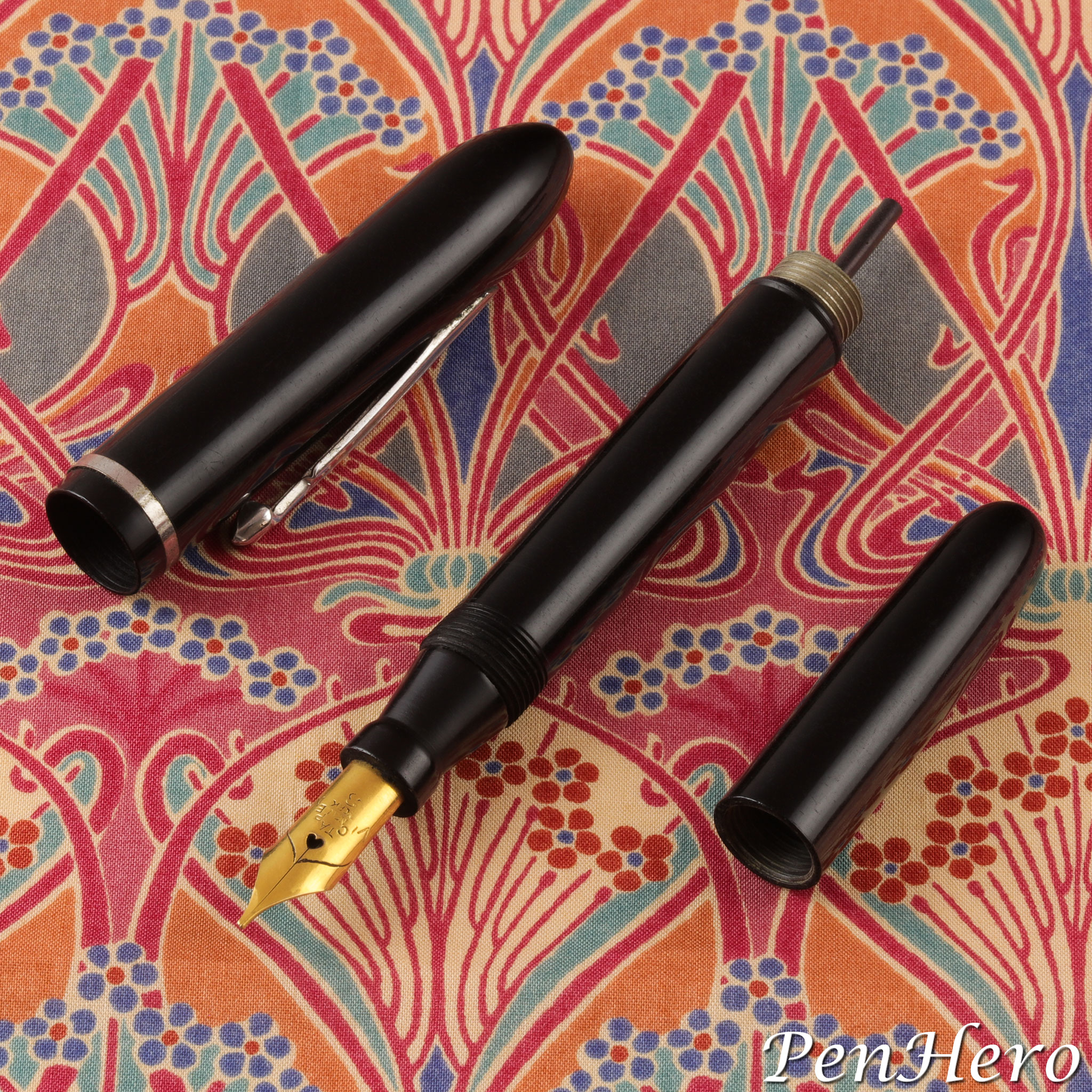 Victor Victapen standard size fountain pen black c. late 1930s
Victor Victapen standard size fountain pen black c. late 1930s
The few Victapen restorations I've seen were all done with standard straight ink sacs. I don’t find this overly successful and wonder if the original, larger bulb end sac worked better. Given the very small size and quirky design of the typical Victapen, I see them more as collectibles than users.
Victor Victapens are well-made with an interesting design given the convertible feature. They come in a variety of celluloids and clip and cap band styles. They are not common, so building a collection may take time. This is the only standard size Victapen I’ve seen. Who knows how many more exist? The small Victapens don't command high prices. I'm frequently encountering new ones and hope someday to see an all metal gold-filled Victapen! Consider the Victor Victapen if you like collecting unusual small writing instruments!
PenHero Article Reference
“Victor Victapen 'Midget' c. 1932 to 1949”
References
Advertisement, Boys’ Life, May 1936, page 42
Advertisement, Careta, Rio de Janeiro, Brazil, December 12, 1942, page 7
Advertisement, Jornal Das Mocas, Rio de Janeiro, Brazil, April 3, 1947, page 16
Advertisement, Jornal Das Mocas, Rio de Janeiro, Brazil, April 17, 1947, page 7
Advertisement, La Noite Ilustrada, Rio de Janeiro, Brazil, October 17, 1944, page 2
Advertisement, La Noite Ilustrada, Rio de Janeiro, Brazil, March 13, 1945, page 20
Advertisement, La Noite Ilustrada, Rio de Janeiro, Brazil, November 5, 1946, page 20
Advertisement, La Noite Ilustrada, Rio de Janeiro, Brazil, November 25, 1947, page 12
Advertisement, Mennonite Weekly Review, September 8, 1949, page 4
Advertisement, New York Daily News, December 22, 1936, page 5
“Behind the Victor” Jonathan A. Veley, June 8, 2020, © Copyright 2011-2016
"Sales Help Male" Classified Advertisement, Hartford Courant, August 27, 1933, page B6
Press Releases, United States Office of Price Stabilization, Browne-OPS-GPR-1084, December 6, 1951
Victor Convertible Sets, instruction set for Victapen, U. S. Victor Fountain Pen Company, Inc., undated, but text indicates post World War II
U. S. Patent 1,918,844, awarded July 18, 1933
United States Patent Office Trademark 583312, registered December 8, 1953
Interact
Comments on this article may be sent to the author, Jim Mamoulides


